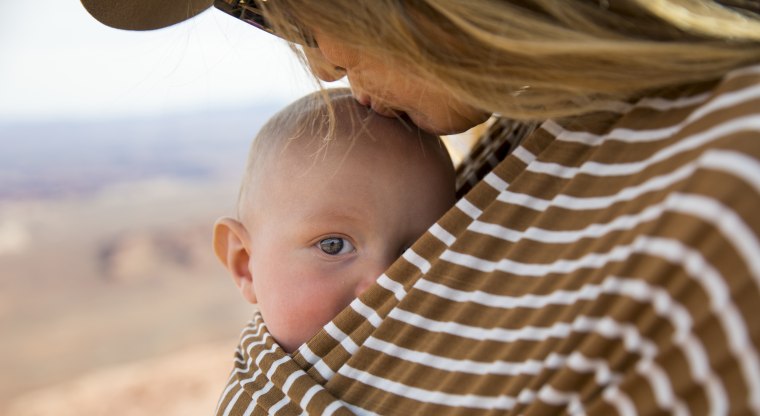Walk around nearly any town and you will see at least one parent or caregiver with a baby strapped to their chest or on their back. And no, those parents aren't carrying babies in their arms or giving endless piggyback rides — they are baby wearing.
Baby wearing is the practice of wearing or carrying a baby in some form of carrier or sling.
Dr. Jenelle Ferry, neonatologist and director of feeding, nutrition and infant development at Pediatrix Neonatology of Florida, tells TODAY.com that baby wearing has been around "almost as long as humans."
"Early humans were nomadic and wore their babies for safety, to conserve energy and to have their arms free for gathering," she says. "Having the baby close also allowed for more frequent feedings when needed."
Ferry says that for some cultures, baby wearing has remained prevalent.
"The concept came once again to America in the 1960s when the Snugli carrier was invented, inspired by seeing African women carrying their infants on their backs during the inventor’s Peace Corps trip," Ferry says. "Then in the 1980s, after a couple of different inventions — one in Germany, then one in Hawaii — Dr. William Sears bought the concept from the Hawaiian inventor."
Sears' wife, Mary, coined the term “baby wearing” after using a sling with her son, and her husband introduced the concept of “attachment parenting.”
Baby Wearing Benefits
There are many benefits to baby wearing. Ferry says that this is true especially with newborns.
"The physical contact of baby with mom can increase mom’s oxytocin levels, which can both improve breastfeeding and increase the parental bond," she says.
Slings can allow infants to be close and offer privacy for breastfeeding mothers.
"Some mothers can even nurse hands-free with their infant in a sling," Ferry says.
The Florida-based doctor tells TODAY.com that dads can similarly increase their parental bond with close contact and can also experience closeness while bottle feeding.
Ferry tells TODAY.com that additional baby wearing benefits include:
- Babies who are carried are generally calmer and cry less.
- Having your baby close can also help them develop socially as they become familiar with facial expressions and language.
- Baby wearing has also been shown to reduce the likelihood of both developmental hip dysplasia and Plagiocephaly, or flattening of the skull.
- Baby wearing can also have the added advantage of keeping a caregiver’s hands free for other tasks.
Baby Wearing Safety Tips
Many parents may wonder — is baby wearing safe?
Ferry tells TODAY.com that yes, baby wearing is safe, as long as you ensure you are using the appropriate device for your infant’s age and developmental stage.
"For example, infants should not be facing outward in a front carrier until they are able to have good head control," she says.
Ferry also cautions parents and caregivers to ensure that whatever position your baby is in maintains an open airway so they don’t have obstructed breathing.
"The baby should be tightly secured, close to the caregiver’s body with the chin off the chest to ensure comfortable breathing and with a supported back," she says.
Is Baby Wearing Good For Baby?
Ferry says there are no disadvantages to baby wearing when it is done appropriately with the principles of maintaining safe breathing in mind.
"In the early 1900s, the concept of spoiling babies with love and attention became commonplace and made baby wearing a much less desirable concept," she says.
This theory has since been disproven.
"In reality, babies thrive with love and attention," Ferry tells TODAY.com "Lack of physical contact with humans and lack of attention can actually delay a baby’s development."
Related video:

